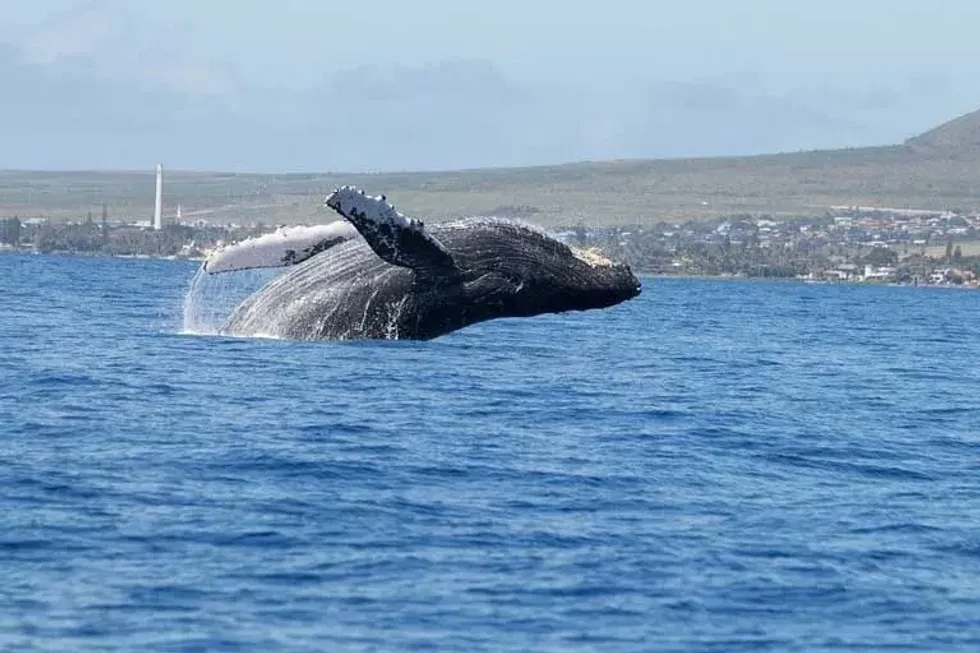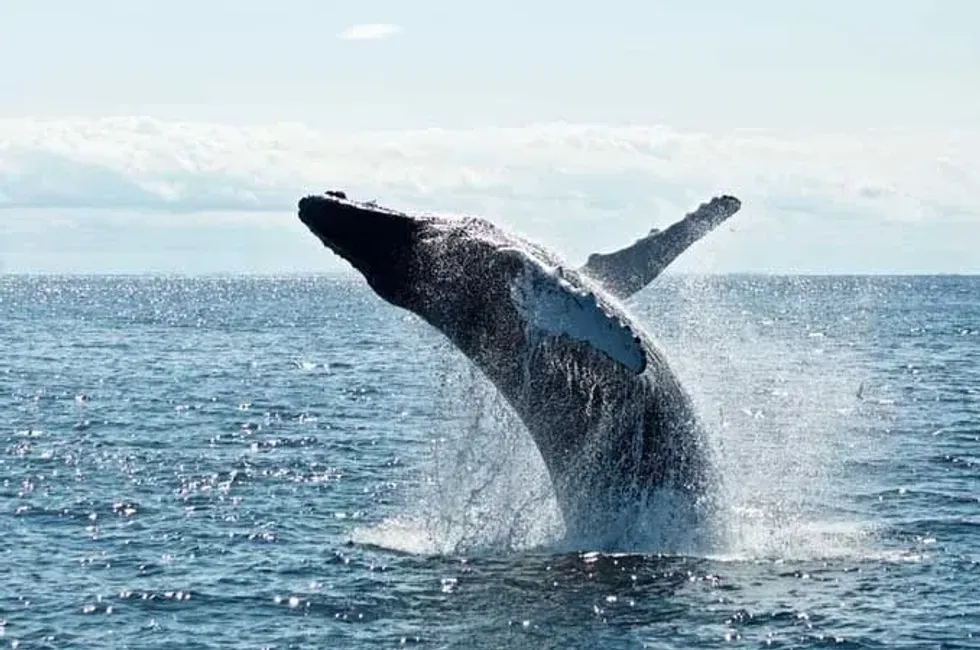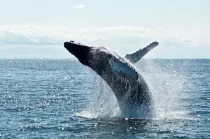Fun Humpback Whale Facts For Kids
Content
- What type of animal is a humpback whale?
- What class of animal does a humpback whale belong to?
- How many humpback whales are there in the world?
- Where does a humpback whale live?
- What is a humpback whale's habitat?
- Who do humpback whales live with?
- How long does a humpback whale live?
- How do they reproduce?
- What is their conservation status?
- What do humpback whales look like?
- How cute are they?
- How do they communicate?
- How big is a Humpback whale?
- How fast can a humpback whale move?
- How much does a humpback whale weigh?
- What are their male and female names of the species?
- What would you call a baby humpback whale?
- What do they eat?
- Are they dangerous?
- Would they make a good pet?
- Did you know...
- Why is it called humpback whale?
- What sound does a humpback whale make?
- How long can a humpback whale hold its breath?
Humpback whales are large baleen whales with the scientific name Megaptera novaeangliae. They survive in large water oceans and seas feeding on an omnivorous diet of plankton, krill and fish. They have a black dorsal side and a white ventral side. Humpback whales are also characterized by their baleen plates, large pectoral fins, and unique dorsal fin.
Humpbacks survive in large water bodies and are known to have four distinct populations based on their location. This includes Polar waters (Population near Maine and Alaska), Pacific ocean (North Pacific population), Atlantic Ocean (North Atlantic population) and Indian Ocean population.
They also cover a humpback whale migration distance of 16,000 miles every year. During this migration, they prefer to be near their feeding grounds in summer, and breeding grounds in winter.
Two unique and interesting facts about humpback whales are seen in their breaching habits - surface behavior by males, and their long whale songs. Both behaviors are known to attract females during the breeding season. While they are presently not endangered, they continue to face threats due to commercial whaling and fishing industries.
At Kidadl, you can explore several interesting wild animals and species articles, including leopard seal facts and fennec fox facts.
Humpback Whale Interesting Facts
What type of animal is a humpback whale?
Humpbacks are very large fish with the scientific name Megaptera novaeangliae. They are called baleen whales because they have hundreds of small, teeth-like baleen plates on the upper side of their jaw.
Humpbacks are also called 'rorqual humpback whales', which are large whales under the family Balaenopteridae. These large whales are known by their long common name, Humpback Whale Megaptera novaeangliae.
What class of animal does a humpback whale belong to?
Humpbacks are marine mammals, belonging to the class Mammalia. A female humpback gives birth to a baby humpback whale Megaptera novaeangliae once every two or three years.
How many humpback whales are there in the world?
As per IUCN, there are at least 80,000 humpback whales, Megaptera novaeangliae, spread across the globe. Of this total number, about 18,000–20,000 humpbacks are found in North Pacific waters, and another 50,000 humpbacks are spread in the Southern Hemisphere. The remaining 12,000 of these large baleen whales are found in North Atlantic waters.
These are high numbers, justifying the current conservation status of Least Concern. But this whale population was considered an Endangered Species as recently as 1998!
Their numbers have since risen due to conscious efforts by the NOAA (National Oceanic and Atmospheric Administration, US). Humpback whale populations continue to face threat, from commercial whaling, and death due to entanglement in fishing gear.
Where does a humpback whale live?
Humpbacks live in large water bodies, like the ocean or the sea. They are accordingly found in Polar waters (near Maine and Alaska), the Pacific Ocean (North Pacific population), Atlantic Ocean (North Atlantic population), and Indian Ocean.
They also cover a large migration distance of 16,000 miles during the year. So their location depends on the time of the year.
For instance, they are more likely to be found in high latitude and cooler regions during summer (like the Gulf of Maine, gulf of Alaska, etc.). They seek their breeding grounds in warmer water temperatures in winter, near Hawaii, Panama, Costa Rica, Japan, and various parts of Africa and Australia.
Humpback Whales found in the Arabian Sea continue to live there all year.
What is a humpback whale's habitat?
Given their size, it is not surprising that humpback whales live in oceans and seas, and travel all over the world through these large water bodies.
They cover a humpback whale migration distance of 16,000 m (25,7450 kms) in the water every year.
During this time, humpbacks survive feeding on an omnivorous diet of zoo plankton, small crustaceans (collectively called krill), and small fish. Humpback whales are also known to have a straightforward migration routine, which helps to identify locations where they can be sighted during different times in the year.
For instance, they are commonly found in high latitude areas like the Gulf of Maine and Alaska in summer, where they actively seek out their summer feeding grounds.
In contrast, humpbacks are more likely to be found near warmer waters for their breeding grounds in winter. This includes Hawaii, Panama, Costa Rica, and various parts of Africa and Australia.
Some humpback whales are also known to migrate to the Sea of Japan in winter. Finally, humpback whales found in the Arabian sea are not migratory in nature. They remain feeding and breeding in these waters, all through the year.
Who do humpback whales live with?
Humpback whales can be solitary in nature or live in small groups of two or three humpbacks, called pods. They use a range of communication methods within these pods, including whale songs and breaching, and whale noises like bellowing, snorting and grunting.
Pods of humpback whales can also include combination of females with their children, especially during the migration period. Here, females are known to touch the fins of their young ones (calves) as a form of loving communication.
Young whale calves also live with their mother for at least a year (while they nurse) in pods, before they choose to venture out on their own.
How long does a humpback whale live?
The life span of humpback whales is variable. They can live anywhere between 45 and 100 years. However, they continue to be mildly endangered due to commercial whaling and fishing industries.
How do they reproduce?
The breeding season of humpback whales is mostly in winter. During this time, they seek out breeding grounds in warm waters (like Hawaii, Central and South America, also Africa and Australia).
During this time, there is fierce competition among males to court females. In fact, it is common to see many males circling a single female humpback whale, not in threat, but in courtship!
Humpback whales also use a range of surface behaviors (called breaching), along with slapping their fins and tails to attract females. Whale songs also play an important role in establishing dominance among competing males.
Females are larger in size than males, and mate with multiple males during their life. A female may also deliver a calf (baby whale) every two or three years.
Once a pair mate, the gestation period lasts for almost a year. So they also give birth in the winter period – in January/ February in the Northern Hemisphere, and in July/ August in the Southern Hemisphere (Australia, Costa Rica).
Baby whales (calves) can weigh up to 1984.1 lb (900 kg) when they are born. They remain with the mother for at least a year, to nurse. The milk of whale females is filled with fat, and helps calves quickly grow into their massive size. The calves also continue to grow, until they are around 10 years old.
What is their conservation status?
The official conservation status of humpback whales is of Least Concern. This seems reasonable, as there an expected 80,000 humpbacks spread all over the world. The NOAA has put in a lot of effort since then to raise numbers, and protect this large whale species for the future.
Humpback whales continue to face threat from commercial whaling, and death due to entanglement in fishing gear. In fact, humpback whales are still considered vulnerable or at risk in the Arabian sea, west coast of Africa, and parts of Oceania.
Humpback Whale Fun Facts
What do humpback whales look like?

Humpback whales are very large, with a gray-black dorsal (top) side and a white ventral (bottom) side. Their skin is covered in blubber, with a high fat content.
This helps to sustain them during long migration journeys when they cannot take daily feeding for granted. They are characterized by two massive pectoral fins near their tail, and a unique dorsal fin used to identify individual whales. Finally, they have a huge but lumpy body which can weigh thousands of pounds!
How cute are they?
Humpback whales are gentle giants with a high cuteness quotient. You see, this mighty whale species seems to consider itself somewhat of a musical genius, using humpback whale songs to communicate with other males and attract females!
During their breeding season in winter, males can sing their whale songs for hours to attract a mate. This is also used to establish dominance among other males competing for the same female.
In fact, it is common for a male to pick up another male’s whale song. Also, given their hefty visage, it is not surprising that these whale songs can be heard from quite a distance, up to 20 miles (32.2 km) away!
Another cute fact about humpback whales is their love for breaching, where males jump on the surface of the water making acrobatic movements with their fins and tails. In fact, they love to show off with these breaching movements and make quite a visual spectacle to onlookers!
Humpback whales have many endearing qualities. But it is perhaps their eccentric singing talent and acrobatic breaching that makes them ultra cute!
How do they communicate?
Humpback whales use both verbal and non-verbal communication among males and females. They use a range of sounds – including whale songs and grunting, snorting, bellowing, groaning noises to communicate with other whales. They also use distinctive whale behavior – like breaching, to communicate between males and attract females during the breeding season.
How big is a Humpback whale?
The humpback whale size is comparable to a large school bus. Humpbacks are also known for their extraordinarily long pectoral fins, measuring a grand 20 ft (6 m) in length. Also, even a small baby whale (calf) can weigh up to 1984.1 lb (900 kg). Yes, these are massively big animals by any standard!
How fast can a humpback whale move?
For such a bulky creature, a humpback whale can be surprisingly agile in the water. These Humpbacks can move at a rapid speed of 15 mph (25 kph)!
How much does a humpback whale weigh?
Humpback whales are giant marine mammals, weighing around 56,000–66,000 lb (25,000-30,000 kg). To manage this massive weight, Humpbacks can eat as much as 3,000 lb (1361 kg) of food every day.
What are their male and female names of the species?
Both genders are simply called as humpback whales. But they do exhibit mild sexual dimorphism. Female humpback whales are bigger in size, and have a small lump about 6 in (15.2cm) wide near their tail (in their genital region). This is called the hemispherical lobe, and is used by humans to determine the gender of this whale population.
What would you call a baby humpback whale?
A baby humpback whale is called a calf. And yet, they look nothing like human babies or cow calves with a enormous length of up to 15 feet (4.6 m). The babies in this whale population also weigh a hefty 900 kgs (1984.1 lbs)!
What do they eat?
Humpback whales are omnivores, feeding on a diverse marine diet of zoo plankton, krill (small crustaceans) and small fish.
Are they dangerous?
Humpback whales are not dangerous to humans. They are not carnivores. In fact, they are harmless omnivores, feeding on a diet of plankton, krill and small fish.
But they can get aggressive during the breeding season, as multiple whale males compete for females. During this time, they may exhibit mildly aggressive behavior (like bellowing or grunting sounds, slapping of tails and fins, etc.).
They are also enormously curious creatures. So, the only “danger” they can pose is when they sight you in an ocean or sea, and come forward to have a closer look. This may catch you of guard (or capsize your boat) if you are unprepared.
Would they make a good pet?
Humpback whales are friendly creatures. So in theory, they can make good pets.
But keep in mind that they are enormous creatures, weighing 28 – 33 short tons(56,000 – 66,000 lbs). They are also most happy feeding on a daily diet of 1361 kgs (3,000 lbs) of marine life every day, when not in migration. So it is impossible to maintain such a huge creature in a domestic habitat.
Did you know...
Humpback whales have a dorsal fin on their upper side, which can be used to identify individual whales in this species. In fact, the dorsal fin of each whale is unique, in terms of shape, color and pattern, much like human fingerprints.
These are not to be confused with their pectoral fins, also a characteristic feature of humpbacks due to their length up to 20ft (6 m).
Why is it called humpback whale?
First, humpback whales are not fish with humps! Their name actually comes from their breaching (surface behavior), as they perform several acrobatic postures on the water surface with their fins and tails.
During this time, they arch their backs for various postures, giving them a hump-like appearance. Their breaching is also an endearing quality of humpback whales, used to communicate between males and females of this species. It is hence fitting that they also get their name from this unique quality.
Another interesting fact about this species is the source for their scientific name, Megaptera novaeangliae, which literally means 'big wings of New England' in Latin. When Europeans first sighted them migrating off New England, humpback whales were given this name in reference to their big pectoral fins.
What sound does a humpback whale make?
Humpback whales make many sounds, including grunting, snorting, bellowing, and groaning. They are most famous for their 'whale songs', with males 'singing' to each other loudly during the breeding season. This may be used to establish dominance and attract females. Also, the mighty whale song can be heard from a distance of 20 miles (30 km)!
How long can a humpback whale hold its breath?
These large fish do everything in big size! Humpback whales breathe voluntarily, and can hold their breath for almost 45 minutes!
Here at Kidadl, we have carefully created lots of interesting family-friendly animal facts for everyone to discover! For more relatable content, check out these giant anteater facts and plains zebra facts for kids.
You can even occupy yourself at home by coloring in one of our free printable humpback whale coloring pages.
We Want Your Photos!
More for You
See All
Bachelors in Business Administration

Aashita DhingraBachelors in Business Administration
Based in Lucknow, India, Aashita is a skilled content creator with experience crafting study guides for high school-aged kids. Her education includes a degree in Business Administration from St. Mary's Convent Inter College, which she leverages to bring a unique perspective to her work. Aashita's passion for writing and education is evident in her ability to craft engaging content.
Disclaimer
1) Kidadl is independent and to make our service free to you the reader we are supported by advertising. We hope you love our recommendations for products and services! What we suggest is selected independently by the Kidadl team. If you purchase using the Buy Now button we may earn a small commission. This does not influence our choices. Prices are correct and items are available at the time the article was published but we cannot guarantee that on the time of reading. Please note that Kidadl is a participant in the Amazon Services LLC Associates Program, an affiliate advertising program designed to provide a means for sites to earn advertising fees by advertising and linking to Amazon. We also link to other websites, but are not responsible for their content.
2) At Kidadl, we strive to recommend the very best activities and events. We will always aim to give you accurate information at the date of publication - however, information does change, so it’s important you do your own research, double-check and make the decision that is right for your family. We recognise that not all activities and ideas are appropriate for all children and families or in all circumstances. Our recommended activities are based on age but these are a guide. We recommend that these ideas are used as inspiration, that ideas are undertaken with appropriate adult supervision, and that each adult uses their own discretion and knowledge of their children to consider the safety and suitability. Kidadl cannot accept liability for the execution of these ideas, and parental supervision is advised at all times, as safety is paramount. Anyone using the information provided by Kidadl does so at their own risk and we can not accept liability if things go wrong.
3) Because we are an educational resource, we have quotes and facts about a range of historical and modern figures. We do not endorse the actions of or rhetoric of all the people included in these collections, but we think they are important for growing minds to learn about under the guidance of parents or guardians.







